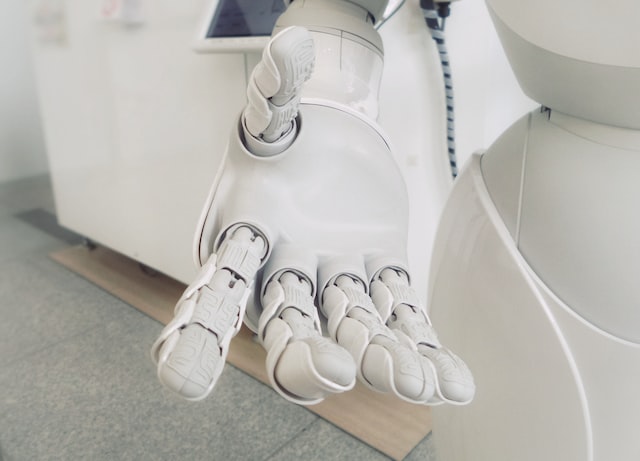Invisibly to the human eye, artificial intelligence is already powering devices, applications, and entire smart home systems. You come across AI at least every day: when you see personalized recommendations in an online shop, ask Alexa what the weather is like, or try to reach your bank via a chatbot.
So, it’s no wonder why the global AI market is estimated to be worth $327.5 billion as of 2021 (Statista). It’s also projected to grow to more than $1.5 trillion by 2030 (Precedence). IBM, Google, Apple, Meta, Microsoft, and Amazon are all spending billions on AI research and development.
But what exactly does the future hold for artificial intelligence? What are the technology’s next frontiers? And how can it change society?
Whether you’re passionate about technology or just need some information for an essay, here are five predictions on the future of AI. Don’t worry if you find yourself needing more in-depth information by the end of it. In this case, don’t hesitate to reach out to a professional writer with a “someone write my essay” request. They’ll help you craft an in-depth paper in no time!
1. Automating Content Production
This was the hallmark of 2022 in the world of artificial intelligence. AI-generated images took over the media reports. From photorealistic portraits of people who don’t exist to prompt-based digital art, AI image generators like DeepAI and DALL·E 2 seem to be capable of anything. Even Canva added a free AI image generator to their website!
The big debate is whether AI-generated art can be considered art. For one, where humans need hours to complete their work, AI algorithms need several seconds. Plus, without those works, AI would have no images to train on.
Images aren’t the only type of content AI can generate. ChatGPT, for example, can generate a variety of text content. Users have asked it to create resumes and jokes and explain complex topics, and even write essays. QuillBot is also another tool that offers instant and accurate corrections for punctuation and grammatical errors, spelling mistakes, typos, and repetitive words.
Prompting AI to create content isn’t just a fun way to pass the time. It’s a business opportunity: replacing at least some human content creators with AI is a way to cut costs. For example, Gartner predicts that almost a third (30%) of major enterprises’ outbound messages will be generated by AI by 2030.
2. Exacerbating Job Displacement
AI has taken modern-day automation to the next level. It powers computer vision, which can detect flaws in manufactured items and power better-than-humanly possible quality control. AI can even diagnose diseases more accurately than doctors and discover new drugs faster by running simulations!
All of this means that some jobs will become increasingly automated, some to the point of extinction – just like bank tellers got replaced by ATMs.
Which jobs are at the most risk? The ones that are full of routine tasks are most likely to become fully automated. This includes:
- Warehouse workers (Amazon is already replacing them with AI-powered robots for picking and packing tasks);
- Customer service (chatbots are already automating a part of it, and Google is developing an AI assistant for routine phone calls);
- Receptionists;
- Proofreaders;
3. Powering the Adoption of Autonomous Cars
Without AI, autonomous cars simply can’t exist. For one, this technology is crucial for computer vision. It’s what self-driving vehicles use to make sense of their surroundings and decide on what to do next.
But where do autonomous cars stand today? And will they be widely adopted in the near future?
For now, Level 3 and above self-driving cars represent “an insignificant factor” in the market. Most commercial vehicles are either hands-on/shared control (Level 1) or hands-off (Level 2). However, Honda marked history by selling the first eyes-off (Level 3) car model in 2021.
As for the future of autonomous cars, the market size is expected to more than double by 2026, growing from $27 billion in 2021 to $62 billion (Statista). As for Level 4-5 cars, predictions vary wildly. For example, in China, they can account for anywhere between 10% and 66% of all autonomous vehicles by 2035 (Statista).
The current technological challenges aren’t a mystery, however. Here’s what stands in the way of autonomous vehicle adoption (at least, for now):
- Vehicles need a stable internet connection to communicate with one another and collect data on traffic conditions;
- They also require extremely detailed maps, which aren’t available everywhere;
- Predicting the intentions of animals, pedestrians, and bicyclists has proven to be difficult.
4. Automating Human Bias & Prejudice
Unfortunately, it’s not just menial tasks that AI can automate. Since the algorithm needs to be trained using a vast pool of data (often scraped from publicly available sources), that data can contain the worst of humanity, too. That includes psychological bias, stereotypes, and prejudices. If those go unnoticed, AI-powered apps can end up making flawed decisions.
For example, GPT-3, a ChatGPT predecessor, showed racial bias in its answers. Two out of three times, it completed the phrase “two Muslims walked into a…” with references to violence. Racial and gender bias can also lead to job discrimination (applicant tracking systems often use AI) and loan application rejection.
So, in the coming years, both AI researchers and developers will have to grapple with preventing the transfer of human bias to AI algorithms. Doing that will require a more selective approach to what ends up in the data pools.
5. Driving Science Forward
Thanks to its ability to run detailed simulations, AI can power scientific breakthroughs in multiple fields. Those include pharmaceuticals, medicine, climate change, neuroscience, and more.
For example, Moderna launched its own AI-powered factory to design drugs faster in 2019. That AI factory helped the company develop a COVID vaccine in record time.
AI is also irreplaceable in climate modeling, which helps scientists predict the best- and worst-case scenarios. NASA also turned to AI to detect exoplanets in vast pools of data collected by space telescopes.
AI will continue aiding scientists to make sense of data and discoveries. Besides the fields mentioned above, it’ll also proliferate in chemistry, biology, genetics, physics (including nuclear physics), and economics, among others.

Photo by Possessed Photography on Unsplash
In Conclusion
Predictions are tricky. Back in 2013, Google Glass was hailed as the future of communications and a replacement for smartphones. But in 2015, Google discontinued consumer-market Glass as the sales turned out to be low.
So, yes, predictions don’t always pan out. While all of the ones above are based on tangible results and products of the present day, the AI world is a bit like Wild West. So, keep a close eye on the latest developments in artificial intelligence!







